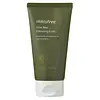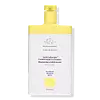What's inside
What's inside
 Key Ingredients
Key Ingredients

No key ingredients
 Benefits
Benefits

 Concerns
Concerns

 Ingredients Side-by-side
Ingredients Side-by-side

Water
Skin ConditioningMyristic Acid
CleansingGlycerin
HumectantPotassium Hydroxide
BufferingPEG-32
HumectantStearic Acid
CleansingButylene Glycol
HumectantOlive Oil PEG-8 Esters
EmollientPalmitic Acid
EmollientGlyceryl Stearate
EmollientPEG-100 Stearate
Cocamidopropyl Betaine
CleansingLimonene
PerfumingPolyquaternium-7
Sodium Chloride
MaskingOlea Europaea Fruit Oil
MaskingParfum
MaskingDisodium EDTA
Sodium Benzoate
MaskingLactic Acid
BufferingWater, Myristic Acid, Glycerin, Potassium Hydroxide, PEG-32, Stearic Acid, Butylene Glycol, Olive Oil PEG-8 Esters, Palmitic Acid, Glyceryl Stearate, PEG-100 Stearate, Cocamidopropyl Betaine, Limonene, Polyquaternium-7, Sodium Chloride, Olea Europaea Fruit Oil, Parfum, Disodium EDTA, Sodium Benzoate, Lactic Acid
Water
Skin ConditioningCetyl Alcohol
EmollientCetearyl Alcohol
EmollientGlycerin
HumectantStearamidopropyl Dimethylamine
EmulsifyingSclerocarya Birrea Seed Oil
HumectantArgania Spinosa Kernel Oil
EmollientPlukenetia Volubilis Seed Oil
EmollientRosa Canina Fruit Oil
EmollientCaprylic/Capric Triglyceride
MaskingSimmondsia Chinensis Seed Oil
EmollientBehentrimonium Methosulfate
Brassicamidopropyl Dimethylamine
Skin ConditioningAloe Barbadensis Leaf Juice
Skin ConditioningSodium PCA
HumectantCapryloyl Glycerin/Sebacic Acid Copolymer
Skin ConditioningPanthenol
Skin ConditioningSodium Lactate
BufferingPCA
HumectantAlanine
MaskingArginine
MaskingGlycine
BufferingHistidine
HumectantIsoleucine
Skin ConditioningPhenylalanine
MaskingProline
Skin ConditioningSerine
MaskingThreonine
Valine
MaskingDiheptyl Succinate
EmollientVanilla Planifolia Fruit Extract
Skin ConditioningAspartic Acid
MaskingCocamidopropyl Betaine
CleansingCitric Acid
BufferingGluconolactone
Skin ConditioningStearyl Alcohol
EmollientPhenoxyethanol
PreservativeCaprylyl Glycol
EmollientSodium Chloride
MaskingSodium Glycolate
BufferingChloroacetic Acid
Sodium Hydroxide
BufferingHexylene Glycol
EmulsifyingEthylhexylglycerin
Skin ConditioningWater, Cetyl Alcohol, Cetearyl Alcohol, Glycerin, Stearamidopropyl Dimethylamine, Sclerocarya Birrea Seed Oil, Argania Spinosa Kernel Oil, Plukenetia Volubilis Seed Oil, Rosa Canina Fruit Oil, Caprylic/Capric Triglyceride, Simmondsia Chinensis Seed Oil, Behentrimonium Methosulfate, Brassicamidopropyl Dimethylamine, Aloe Barbadensis Leaf Juice, Sodium PCA, Capryloyl Glycerin/Sebacic Acid Copolymer, Panthenol, Sodium Lactate, PCA, Alanine, Arginine, Glycine, Histidine, Isoleucine, Phenylalanine, Proline, Serine, Threonine, Valine, Diheptyl Succinate, Vanilla Planifolia Fruit Extract, Aspartic Acid, Cocamidopropyl Betaine, Citric Acid, Gluconolactone, Stearyl Alcohol, Phenoxyethanol, Caprylyl Glycol, Sodium Chloride, Sodium Glycolate, Chloroacetic Acid, Sodium Hydroxide, Hexylene Glycol, Ethylhexylglycerin
Ingredients Explained
These ingredients are found in both products.
Ingredients higher up in an ingredient list are typically present in a larger amount.
Cocamidopropyl Betaine is a fatty acid created by mixing similar compounds in coconut oil and dimethylaminopropylamine, a compound with two amino groups.
This ingredient is a surfactant and cleanser. It helps gather the dirt, pollutants, and other impurities in your skin to be washed away. It also helps thicken a product and make the texture more creamy.
Being created from coconut oil means Cocamidopropyl Betaine is hydrating for the skin.
While Cocamidopropyl Betaine was believed to be an allergen, a study from 2012 disproved this. It found two compounds in unpure Cocamidopropyl Betaine to be the irritants: aminoamide and 3-dimethylaminopropylamine. High-grade and pure Cocamidopropyl Betaine did not induce allergic reactions during this study.
Learn more about Cocamidopropyl BetaineGlycerin is already naturally found in your skin. It helps moisturize and protect your skin.
A study from 2016 found glycerin to be more effective as a humectant than AHAs and hyaluronic acid.
As a humectant, it helps the skin stay hydrated by pulling moisture to your skin. The low molecular weight of glycerin allows it to pull moisture into the deeper layers of your skin.
Hydrated skin improves your skin barrier; Your skin barrier helps protect against irritants and bacteria.
Glycerin has also been found to have antimicrobial and antiviral properties. Due to these properties, glycerin is often used in wound and burn treatments.
In cosmetics, glycerin is usually derived from plants such as soybean or palm. However, it can also be sourced from animals, such as tallow or animal fat.
This ingredient is organic, colorless, odorless, and non-toxic.
Glycerin is the name for this ingredient in American English. British English uses Glycerol/Glycerine.
Learn more about GlycerinChances are, you eat sodium chloride every day. Sodium Chloride is also known as table salt.
This ingredient has many purposes in skincare: thickener, emulsifier, and exfoliator.
You'll most likely find this ingredient in cleansers where it is used to create a gel-like texture. As an emulsifier, it also prevents ingredients from separating.
There is much debate on whether this ingredient is comedogenic. The short answer - comedogenic ratings don't tell the whole story. Learn more about comegodenic ratings here.
The concensus about this ingredient causing acne seems to be divided. Research is needed to understand if this ingredient does cause acne.
Scrubs may use salt as the primary exfoliating ingredient.
Learn more about Sodium ChlorideWater. It's the most common cosmetic ingredient of all. You'll usually see it at the top of ingredient lists, meaning that it makes up the largest part of the product.
So why is it so popular? Water most often acts as a solvent - this means that it helps dissolve other ingredients into the formulation.
You'll also recognize water as that liquid we all need to stay alive. If you see this, drink a glass of water. Stay hydrated!
Learn more about Water